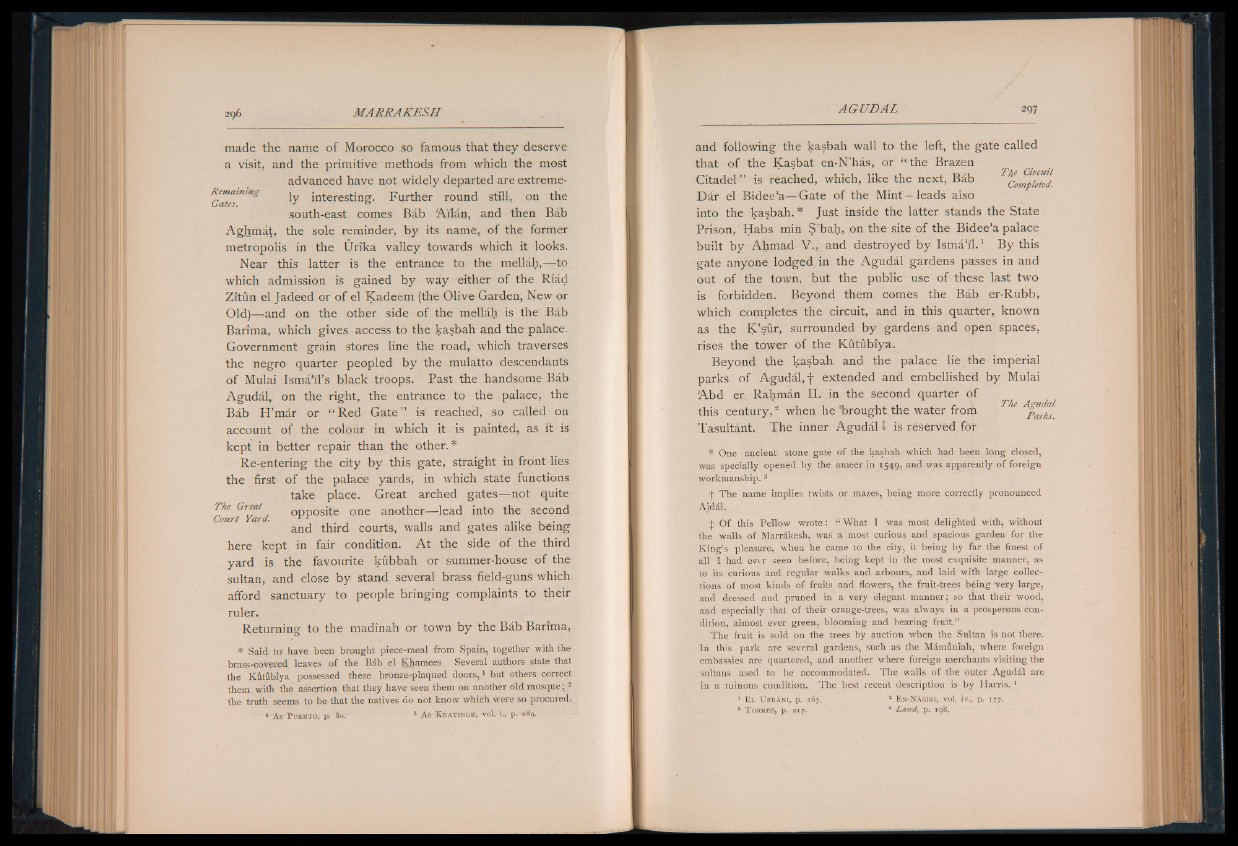
made the name of Morocco so famous that they deserve
a visit, and the primitive methods from which the most
advanced have not widely departed are extreme-
'^ates m”S ^ interesting. Further round still, on the
south-east comes Bab Allan, and then Bab
Aghmdt, the sole reminder, by its name, of the former
metropolis in the Urika valley towards which it looks.
Near this latter is the entrance to the mellah,— to
which admission is gained by way either of the Riad
Zitun el Jadeed or of el Kadeem (the Olive Garden, New or
Old)— and on the other side of the mellah is the Bab
Barima, which gives access to the kasbah and the palace.
Government grain stores line the road, which traverses
the negro quarter peopled by the mulatto descendants
of Mulai Isma*i'l’s black troops. Past the handsome Bab
Agudal, on the right, the entrance to the palace, the
Bab H’mar or “ Red G ate ” is reached, so called on
account of the colour in which it is painted, as it is
kept in better repair than the other.*
Re-entering the city by this gate, straight in front lies
the first of the palace yards, in which state functions
take place. Great arched gates— not quite
The Great opposite one another— lead into the second
Court Yard. .
and third courts, walls and gates alike being
here kept in fair condition. A t the side of the third
yard is the favourite kubbah or summer-house of the
sultan, and close by stand several brass field-guns which
afford sanctuary to people bringing complaints to their
ruler.
Returning to the madinah or town by the Bab Barima,
* Said to’ have been brought piece-meal from Spain, together with the
brass-covered leaves of the Bdb el Khamees Several authors state that
the Kutubiya possessed these bronze-plaqued doors,1 but others correct
them with the assertion that they have seen them on another old mosque; 3
the truth seems to be that the natives do not know which were so procured.
-- 1 - A s “ P u e r t o , p . 80. - ■ --------- 2 A s K e a t i n g e , v o l . 1 , p . 289.
and following the kasbah wall to the left, the gate called
that of the Kasbat en-N’has, or “ the Brazen
Citadel ” is reached, which, like the next, Bab ^completed.
Dar el Bidee’a— Gate of the Mint - leads also
into the kasbah.* Just inside the latter stands the State
Prison, Habs min S ’bah, on the site of the Bidee’a palace
built by Ahmad V., and destroyed by Isma’il. 1 By this
gate anyone lodged in the Agudal gardens passes in and
out of the town, but the public use of these last two
is forbidden. Beyond them comes the Bab er-Rubb,
which completes the circuit, and in this quarter, known
as the K ’sur, surrounded by gardens and open spaces,
rises the tower of the Kutubiya.
Beyond the kasbah and the palace lie the imperial
parks of Agudal, f extended and embellished by Mulai
Abd er. Rahman II. in the second quarter of
this century,3 when he *brought the water froih Parks
Tasultant. The inner Agudal t is reserved for
* One ancient stone gate of the kasbah which had been long closed,
was specially opened by the ameer in 1549, and was apparently of foreign
workmanship. 3
f The name implies twists or mazes, being more correctly pronounced
Ajddl.
£ Of this Pellow wrote: “ What I was most delighted with, without
the walls of Marrakesh, was a most curious and spacious garden for the
King’s pleasure, when he came to the city, it being by far the finest of
all I had evtr seen before, being kept in the most exquisite manner, as
to its curious and regular walks and arbours, and laid with large collections
of most kinds of fruits and flowers, the fruit-trees being -very large,
and dressed and pruned in a very elegant manner; so that their wood,
and especially that of their orange-trees, was always in a prosperous condition,
almost ever green, blooming and bearing fruit.”
The fruit is sold on the trees by auction when the Sultan is not there.
In this park are several gardens, such as the Mamuniah, where foreign
embassies are quartered, and another where foreign merchants visiting the
sultans used to be accommodated. The walls of the outer Agudal are
in a ruinous condition. The best recent description is by Harris.4
1 E l U f r a n i , p . 1 6 7 . 2 E n -N a s i r i , v o l . i v . , p . 1 7 7 .
3 T o r r e s , p . 2 x 7 . 4 L a n d , p . 1 9 8 .